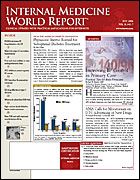Publication
Article
Internal Medicine World Report
Short-term Oral Glucosamine Does not Cause Insulin Resistance
Author(s):
WASHINGTON, DC—Because oral glucosamine tablets are a popular over-the-counter (OTC) product used by many Americans for the treatment of pain associated with osteoarthritis, and are heavily advertised as well, their potential for negatively affecting insulin metabolism and endothelial function merits further investigation. Findings from a recent study presented at the 66th Scientific Sessions of the American Diabetes Association suggest that a short-term course of this OTC agent at standard doses does not cause or worsen insulin resistance or endothelial dysfunction.
“From a metabolic and vascular perspective, oral glucosamine therapy at standard doses for 6 weeks appears safe,” said Rajaram Karne, MD, now assistant professor of clinical medicine at Ohio State University Medical Center, Columbus. Dr Karne, Michael J. Quon, MD, PhD, and colleagues at the National Center for Complementary and Alternative Medicine, National Institutes of Health, Bethesda, MD, evaluated the effects of oral glucosamine at the standard dose (1500 mg/d) for 6 weeks in 20 lean (defined as a body mass index [BMI] ≤25 kg/m2) and 20 obese (BMI ≥30 kg/m2) individuals (age, 22-65 years).
This was the first rigorous, if small, clinical study evaluating the safety of oral glucosamine with respect to insulin resistance and endothelial dysfunction, according to Dr Karne.
Although OTC oral glucosamine supplementation is used extensively for osteoarthritis in this country, its use involves important potential safety concerns when taken in large dosages, said Dr Karne. In cell-based model systems, incubation of muscle, adipose, or endothelial cells with high levels of glucosamine causes impairment in the metabolic actions of insulin as well as endothelial dysfunction, he added.
Furthermore, intravenous (IV) glucosamine administration causes metabolic insulin resistance and vascular endothelial dysfunction in animals and humans. But he was quick to emphasize that the insulin resistance and endothelial dysfunction occurs only when IV glucosamine is administered in significantly higher doses than the OTC formulation commonly used.
In this study, glucosamine or placebo for 6 weeks was followed by a 1-week washout and crossover to the other arm. Insulin sensitivity was assessed by hyperinsulinemic euglycemic glucose clamp, and endothelial function was evaluated by brachial artery blood flow (Doppler ultrasound) and forearm skeletal muscle capillary recruitment (ultrasound with microbubble contrast) before and during hyperinsulinemia.
As expected, at baseline, obese patients had insulin resistance and endothelial dysfunction when compared with lean patients. When compared with placebo, glucosamine did not cause insulin resistance or endothelial dysfunction in lean patients or worsen insulin resistance or endothelial dysfunction in obese patients. The half-life of plasma glucosamine after oral dosing was 3 hours, with no significant changes in steady-state levels after 6 weeks of therapy.





